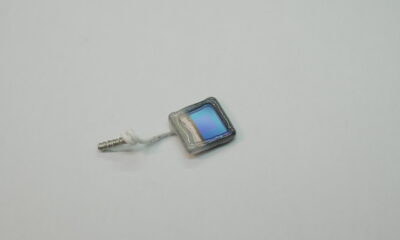Inovation
Building Resilient 6G Networks for Sustainable Urban Connectivity

6G-REFERENCE: Pioneering European Leadership in Microelectronic Solutions for 6G Communication and Sensing Infrastructure
The groundbreaking project, 6G-REFERENCE, is poised to revolutionize the European landscape by spearheading advancements in microelectronic solutions tailored for 6G communication and sensing infrastructure. Through the development of cutting-edge hardware enablers, the project aims to facilitate densified cell-free deployments, propelling Europe to the forefront of 6G innovation.
Named “6G haRdware Enablers For cEll fRee cohEreNt Communications & sEnsing,” the 6G-REFERENCE project focuses on driving radio unit hardware innovations that will underpin 6G densely distributed systems capable of delivering high data rates and advanced sensing capabilities. The vision for 6G networks encompasses the seamless integration of sensing and communications, spanning a spectrum from chemical and physical sensing to localization and positioning.
One of the key challenges in the 6G landscape is the necessity for flexible deployment options, particularly in scenarios where optical fiber access is limited to only a few radio unit access points. This constraint underscores the importance of achieving synchronization in frequency and time over the air, highlighting the critical nature of this technological hurdle. The overarching goal is to enhance data capacity while concurrently supporting distributed sensing functionalities, paving the way for the realization of the full internet of sense.
The 6G-REFERENCE consortium is steadfast in its belief that the ambitious goals set forth can be achieved by leveraging the cm-wave spectrum, specifically in the 10-15GHz range. This strategic focus enables the consortium to explore novel hardware solutions that harmonize sensing and communications, thereby fostering sustainable radio design practices.
Objectives of the Project
- Develop transceiver cm-wave radio frequency hardware innovations to address the data capacity and scheduling challenges in distributed multiple-input multiple-output systems.
- Pioneer novel solutions for precise over-the-air frequency, phase, and time synchronization, essential for high-capacity data rate communication and advanced sensing capabilities.
- Introduce new RF and antenna components with extended spatial and frequency domain selective capabilities, while reducing complexity, cost, and energy consumption.
- Design hardware integrated circuit solutions with a focus on low complexity, cost, and power consumption, enabling sustainable radio design encompassing both communications and sensing functionalities.
- Ensure seamless coexistence with existing services in the 10-15GHz range, balancing the advantages and disadvantages of sub-6GHz and mm-wave solutions. A distinctive aspect of 6G-REFERENCE is its emphasis on frequency range 3 (FR3), garnering significant industrial interest and recognition within 3GPP.
Use Cases and Challenges
In urban environments, the advent of 6G necessitates a sustainable solution capable of meeting escalating traffic demands and population densities, while ushering in transformative capabilities such as the internet of things. The proposed solution by 6G-REFERENCE revolves around ultra-dense cell-free deployments optimized for coherent communications and sensing at cm-waves, effectively balancing the advantages of sub-6GHz and mm-wave ranges.
The envisaged systems encounter five core challenges:
- The imperative need for accurate synchronization among distributed radio units.
- Efficient fronthaul data distribution mechanisms.
- Seamless integration of sensing functionalities.
- Development of low complexity, cost-effective, and energy-efficient radios.
- Ensuring smooth coexistence with other services in the 10-15GHz range. 6G-REFERENCE is committed to devising integrated circuit and antenna component solutions to address all these challenges.
6G-REFERENCE is dedicated to exploring innovative frequency/time synchronization circuits, leveraging recent advancements to expedite synchronization processes. Additionally, the project aims to enhance fronthaul data distribution efficiency among cascaded radio units, enabling integrated monostatic radar sensing capabilities. Within the realm of sensing, environmental sensors integrated into the antenna infrastructure, synchronized for precise localization, and novel antenna array solutions are focal points for exploration.
The ultimate objective of 6G-REFERENCE is to develop hardware enablers that could serve as a benchmark design for future 6G distributed radios.
Impact and Sustainability
By championing microelectronic solutions for communication and sensing infrastructure, 6G-REFERENCE is poised to bolster European leadership in this domain. The project’s hardware enablers for densified cell-free deployments not only facilitate coherent data transmissions but also enhance high-precision localization and sensing capabilities, bridging the realms of physical, chemical, digital, and human interactions.
The green transition advocated by 6G-REFERENCE revolves around the deployment of low-energy distributed nodes in a densified manner, enabling advanced multiuser beamforming schemes for data transmission alongside accurate sensing functionalities. This approach ensures enhanced coverage in high-density urban areas, underpinned by sustainable practices like utilizing integrated circuit hardware for both sensing and communications.
Furthermore, the project aligns with Sustainable Development Goal 13 on climate action by incorporating environmental chemical sensors within the antenna system hardware. This innovation holds the potential to create virtual environmental quality maps and support clean hydrogen energy storage initiatives. While not directly addressing new business models, 6G-REFERENCE indirectly fosters their emergence by integrating communications with localization and passive radar sensing, thereby catalyzing the development of novel applications and ventures.
Central to the project’s ethos is ensuring the commercial viability of the developed hardware solutions through alignment with current standardization activities and a deep understanding of their capabilities and limitations. By cultivating a robust foundation for future standardization endeavors, 6G-REFERENCE aims to solidify its contributions to the evolving landscape of 6G technology.
Consortium Members
- Centre Tecnologic de Telecomunicacions de Catalunya (CTTC)
- Ericsson AB (EAB)
- Universiteit Twente (UT)
- Commissariat à l’Energie Atomique et aux Energies Alternatives (CEA)
- Anteral SL
- MTU Australo Alpha Lab
- Interuniversitair Micro-Electronica Centrum (IMEC)
- Eidgenoessische Technische Hochschule Zuerich (ETHZ)
- Advanced Circuit Pursuit AG (ACP)
- The University of Birmingham (UoB)
Disclaimer:
This information has been provided by the 6G-REFERENCE consortium under EC grant agreement 101139155 and may not necessarily reflect the views of the European Commission.
Kindly note that this article will also be featured in the 23rd edition of our quarterly publication.
-

 Video Games2 days ago
Video Games2 days agoTekken 8: Rise of the Shadows
-

 Video Games1 day ago
Video Games1 day agoGoku Takes on the Dragon Ball FighterZ Arena
-

 Amazon2 days ago
Amazon2 days agoNeil Young Takes a Stand: Pulling Music from Amazon in Protest of Jeff Bezos’ Support for Trump
-

 Tech News2 days ago
Tech News2 days agoSamsung Galaxy UI 8: Embracing the Big Free AI Upgrade
-

 Security2 days ago
Security2 days agoCritical Vulnerability Exposed: Oracle EBS Targeted in Recent Cyber Attacks by Cl0p Hackers
-

 Apple2 days ago
Apple2 days agoExploring the Dystopian Realms of Pluribus: An Apple Original Series Trailer
-

 Microsoft2 days ago
Microsoft2 days agoEnhanced Copilot Features: Creating Office Documents and Gmail Integration
-

 AI1 day ago
AI1 day agoOracle’s Next-Gen Enterprise AI Services Powered by NVIDIA’s Cutting-Edge GPUs
























